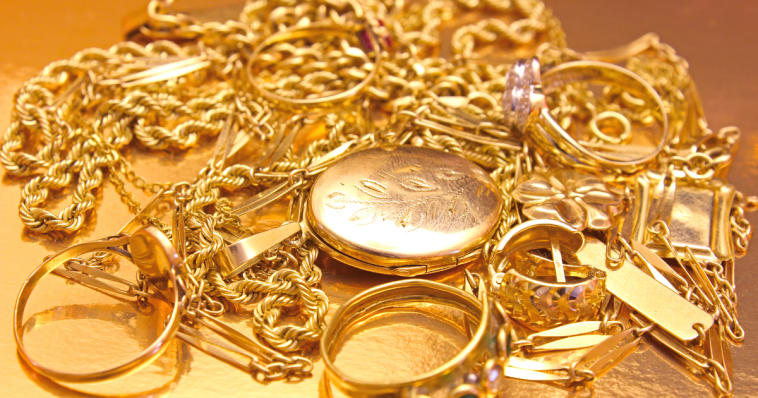Gold jewelry can be a savvy financial choice because it gets more valuable over time. Unlike other investments that might fluctuate with economic shifts, gold stays strong and resists inflation. It’s a form of currency that keeps its worth quickly. Investing in gold jewelry means holding onto something stable, providing a reliable option for safeguarding your money.
When investing in gold jewelry, choosing pieces with high-carat gold, like 18ct or 24ct, is essential. These higher purity levels ensure your investment is in genuine, substantial gold rather than just a thin metal layer. It’s also a good idea to avoid gold-plated jewelry, as it only has a thin layer of gold and doesn’t hold much value as an investment. Make sure to look for hallmarks or maker’s marks on the jewelry, as these indicate the authenticity of the gold, giving you added confidence in your purchase.
Gold Investment
Many view gold as a safeguard against crises, believing it will protect their wealth in tough times. This perception drives many gold purchases as individuals seek the stability they think gold offers. However, it’s worth noting that gold has practical uses beyond being a crisis asset.
In the tech industry, gold is valued for its unique properties, such as its high luster, resistance to tarnish, and ability to be drawn into wires or hammered into sheets. These features make it essential for various technological applications. Additionally, during periods of economic uncertainty, gold is often seen as a safe investment, prompting many to flock to gold as a reliable option amid market volatility.
Advantages of Investing in Gold
Gold plays a significant role in various aspects of life, from cultural traditions to economic stability. Gold retains its intrinsic worth, unlike paper money, which can lose value over time. Its value doesn’t fluctuate as dramatically as stocks’, providing a reliable cashable asset.
Gold is primarily used to create beautiful jewelry and safeguard it during crises. Whether for cultural practices, economic uncertainties, or societal changes, gold has proven to be a valuable and enduring investment.
Why Investing in Gold Jewelry Can Be Worthwhile?
There are various reasons to consider investing in gold jewelry. For starters, it offers a tangible asset that can hold its value and adds elegance to your investment portfolio. The best part? You don’t need to be a financial expert to make an intelligent choice. Investing in gold jewelry is accessible and can be a savvy move for anyone looking to diversify their assets.
Gold jewelry offers excellent portability and liquidity, making it a convenient asset to transport and trade. It can also be a straightforward option if you need cash or want to convert it into other assets. Additionally, gold jewelry can enhance your investment portfolio by providing diversification. Mixing various asset classes—like real estate, cash, and commodities—is a brilliant idea to balance your investments and manage risk effectively.
Here Are Some Reasons to Consider Owning Gold
1. Falling U.S. Dollar Value
While the U.S. dollar is a critical global reserve currency, it can experience periods of weakness. For example, from 1998 to 2008, the dollar’s value fell against other currencies, leading many to seek the stability of gold. This surge in demand contributed to a dramatic rise in gold prices, which nearly tripled during that time, hitting $1,000 an ounce in early 2008 and then climbing above $2,000 by 2012.
The dollar’s value can fluctuate for various reasons over different periods. As the dollar’s strength wanes or improves, so does the demand for gold. This dynamic relationship highlights how gold can be a reliable investment when the dollar’s value is uncertain.
2. Inflation Protection
Gold is often seen as a strong hedge against inflation because its price typically rises when the cost of living increases. During periods of high inflation, gold prices soar while stock markets struggle. This happens because as the value of fiat currency declines, gold, priced in those currency units, also tends to increase in value.
People also turn to gold as a reliable store of value when they sense their local currency is weakening. While gold has historically been a safe bet during inflationary times, it’s important to remember that markets and economic conditions are constantly evolving, and what held true in the past might not always apply today.
3. Protection Against Deflation
Deflation occurs when prices fall, economic activity slows, and debt becomes more burdensome. While global deflation hasn’t been widespread since the Great Depression of the 1930s, there were some deflationary pressures following the 2008 financial crisis in certain regions. During the Great Depression, gold’s purchasing power increased significantly as other prices plummeted.
During this time, people turned to gold as a safe haven for their money. With cash becoming less valuable and financial uncertainty rising, gold and gold coins were seen as the safest place to store wealth. This trend highlighted gold’s ability to retain value even when the economy struggles.
4. Geopolitical Instability
Gold is known for holding its value during financial upheavals and amid geopolitical instability. Often dubbed the “crisis commodity,” gold becomes a go-to safe haven when global tensions escalate.
When confidence in governments wanes, and uncertainties rise, investors flock to gold, seeking its relative safety. As a result, gold frequently outperforms other investments, with its price typically rising the most during geopolitical unrest.
5. Increasing Demand
In recent years, growing wealth in emerging market economies has significantly increased the demand for gold. In many of these countries, gold is deeply woven into cultural traditions. For example, in China, gold bars are a popular way to save and store wealth, leading to a steady demand for the metal.
India, the second-largest consumer of gold globally, also drives substantial demand, particularly during its wedding season in October. Gold is used extensively in jewelry and various cultural practices, making this time of year especially critical for gold consumption worldwide.
Drawbacks of Investing in Gold
Investing in gold has its downsides. One key concern is that gold doesn’t generate income like dividends or interest, meaning you won’t receive regular cash flow from your investment. Additionally, gold prices can be volatile and subject to fluctuations, which can lead to unpredictable returns.
- One significant drawback of investing in gold is that it generates no income. Unlike other investments that offer regular cash flow, such as dividends from stocks, interest from bonds, or rent from real estate, gold only appreciates in value if its price goes up. With gold, your returns depend entirely on the metal’s price movement. This means you won’t receive any ongoing income, making it different from assets that provide consistent earnings while offering the potential for price appreciation.
- Owning and storing gold can come with extra expenses. If you decide to keep gold at home, you must factor in transportation costs and insurance to protect against theft. However, storing large amounts of gold at home can be risky. A bank safety deposit box or specialized gold vault service is safer. While these secure storage solutions offer peace of mind, they also come with fees. These additional costs can affect your overall returns, so it’s essential to consider them when evaluating the investment.
- When selling physical gold for a profit, be prepared for higher taxes. Unlike stocks, bonds, or other investments with a maximum long-term capital gains rate of 20% (or often just 15% for most investors), the tax rate on gold profits can reach up to 28%. This means that a significant portion of your gains could go to taxes, impacting your overall return on investment.
Factors to Consider Before Investing in Jewelry
It’s best to shop at specialized stores with a solid reputation when buying jewelry. Take the time to research the seller—whether it’s a jeweler, goldsmith, or designer. Look into their credentials, read reviews, and ensure they have the expertise to back up their claims.
Before making a purchase, schedule a detailed consultation. Feel free to ask questions about the jewelry’s background and how its value is determined. A trustworthy seller will happily provide you with the information you need to make an informed decision.
When purchasing high-quality jewelry, it’s essential to get all the details in writing from the seller. An invoice that outlines the specifics of the piece—like the fineness of the metal, the color and purity of the diamonds, and the carat weight and origin of any gemstones—provides valuable security and can help with resale in the future.
Why Gold Jewelry is a Timeless and Smart Investment
Investing in gold and gold jewelry can offer a range of benefits, from providing a reliable hedge against economic and geopolitical uncertainties to serving as a valuable addition to your investment portfolio. Its inherent value and stability make it a popular choice, especially during times of crisis. However, it’s crucial to be mindful of the possible drawbacks, such as the lack of income generation, storage costs, and higher taxes on profits.
When considering gold jewelry, ensure you buy from reputable sellers and obtain detailed documentation to safeguard your investment. By weighing the pros and cons and making informed choices, you can take advantage of gold’s benefits while addressing its potential drawbacks.



